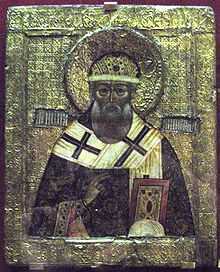Jonah of Moscow

Saint Jonah or Saint Jonas (Иона in Russian) (died 1461?), was the Metropolitan of Moscow from 1448 to his death in 1461. He was the first (independent) Metropolitan of Moscow and all Rus', having been appointed without the approval of the patriarch in Constantinople as was the norm.[1]
Background
Since the late 1420s, Jonah had been living in the Simonov Monastery in Moscow and was close to Metropolitan Photius, who make him Bishop of Ryazan and Murom. After Photius's death in 1431, Grand Prince Vasili II nominated Jonas for the post of Metropolitan, but the Patriarch of Constantinople chose Isidore of Kiev to become the Metropolitan of Kiev and All Rus'.
Metropolitan Without Consent
After Isidore had been condemned by the Russian Orthodox Church in 1441, for his support of Catholicism and the union of the Eastern and Western Churches agreed upon at the Council of Florence-Ferrara, the metropolitan throne sat vacant for seven years, and Jonah became Metropolitan only on December 15, 1448 without the consent of the Patriarch of Constantinople.[2] This signified the establishment of the autocephaly of the Russian Orthodox Church.
Opposition
He spent much of his tenure as the head of the Russian Church opposing the union, including the Lithuanian metropolitanate that threatened to divide the province of Moscow and take the western portion, including the city of Novgorod, away and perhaps lead the western regions of orthodoxy to go over to Catholicism.[3]
Jonah died on March 31, 1461 and was buried in the Cathedral of the Dormition in the Moscow Kremlin. He was canonized by Macarius, the head of the Russian Church, at the Moscow Council of 1547.[4] Ion Island, an island in the Sea of Okhotsk, was formerly named Ostrov Svyatovy Iony after him.
| Preceded by Isidor |
Metropolitan of Moscow and all Russia 1448–1461 |
Succeeded by Theodosius |
References
- ↑ E. E. Golubinskii, Istoriia russkoi tserkvi (Moscow: Universitetskaia tipografiia, 1900), vol. 2, pt. 1, p. 469.
- ↑ Golubinskii, Istoriia russkoi tserkvi, vol. 2, pt. 1, pp. 479-480, 484.
- ↑ Golubinskii, Istoriia russkoi tserkvi vol. 2, pt. 1, pp. 491-2.
- ↑ Golubinskii, Istoriia russkoi tserkvi, vol. 2, pt. 1, p. 515.